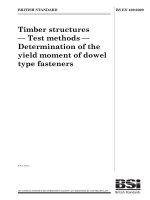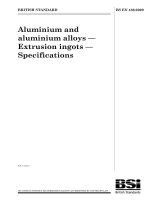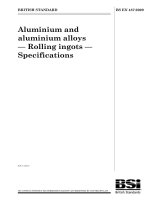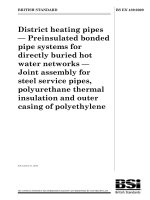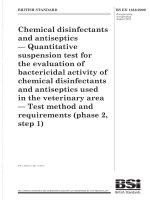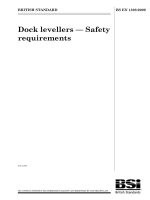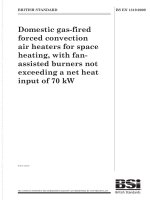Bsi bs en 62295 2009
Bạn đang xem bản rút gọn của tài liệu. Xem và tải ngay bản đầy đủ của tài liệu tại đây (1.43 MB, 68 trang )
BS EN 62295:2009
BSI Standards Publication
Multimedia systems —
Common communication
protocol for inter-connectivity
on heterogeneous networks
BRITISH STANDARD
BS EN 62295:2009
National foreword
This British Standard is the UK implementation of EN 62295:2009. It is
identical to IEC 62295:2007.
The UK participation in its preparation was entrusted to Technical Committee
EPL/100, Audio, video and multimedia systems and equipment.
A list of organizations represented on this committee can be obtained on
request to its secretary.
This publication does not purport to include all the necessary provisions of a
contract. Users are responsible for its correct application.
© BSI 2011
ISBN 978 0 580 76114 0
ICS 33.040.40; 33.160.01; 35.110
Compliance with a British Standard cannot confer immunity
from legal obligations.
This British Standard was published under the authority of the
Standards Policy and Strategy Committee on 31 July 2011.
Amendments issued since publication
Amd. No.
Date
Text affected
BS EN 62295:2009
EUROPEAN STANDARD
EN 62295
NORME EUROPÉENNE
August 2009
EUROPÄISCHE NORM
ICS 33.040.40; 33.160; 35.100
English version
Multimedia systems Common communication protocol
for inter-connectivity on heterogeneous networks
(IEC 62295:2007)
Systèmes multimédia Protocole de communication commun
relatif à la connectivité
entre réseaux hétérogènes
(CEI 62295:2007)
Multimediasysteme Gemeinsames Kommunikationsprotokoll
für die Zusammenschaltung
von heterogenen Netzwerken
(IEC 62295:2007)
This European Standard was approved by CENELEC on 2009-07-01. CENELEC members are bound to comply
with the CEN/CENELEC Internal Regulations which stipulate the conditions for giving this European Standard
the status of a national standard without any alteration.
Up-to-date lists and bibliographical references concerning such national standards may be obtained on
application to the Central Secretariat or to any CENELEC member.
This European Standard exists in three official versions (English, French, German). A version in any other
language made by translation under the responsibility of a CENELEC member into its own language and notified
to the Central Secretariat has the same status as the official versions.
CENELEC members are the national electrotechnical committees of Austria, Belgium, Bulgaria, Cyprus, the
Czech Republic, Denmark, Estonia, Finland, France, Germany, Greece, Hungary, Iceland, Ireland, Italy, Latvia,
Lithuania, Luxembourg, Malta, the Netherlands, Norway, Poland, Portugal, Romania, Slovakia, Slovenia, Spain,
Sweden, Switzerland and the United Kingdom.
CENELEC
European Committee for Electrotechnical Standardization
Comité Européen de Normalisation Electrotechnique
Europäisches Komitee für Elektrotechnische Normung
Central Secretariat: Avenue Marnix 17, B - 1000 Brussels
© 2009 CENELEC -
All rights of exploitation in any form and by any means reserved worldwide for CENELEC members.
Ref. No. EN 62295:2009 E
BS EN 62295:2009
EN 62295:2009
Foreword
The text of document 100/1200/CDV, future edition 1 of IEC 62295, prepared by technical area 8,
Multimedia home server systems, of IEC TC 100, Audio, video and multimedia systems and equipment,
was submitted to the IEC-CENELEC parallel vote and was approved by CENELEC as EN 62295 on
2009-07-01.
The following dates were fixed:
– latest date by which the EN has to be implemented
at national level by publication of an identical
national standard or by endorsement
(dop)
2010-04-01
– latest date by which the national standards conflicting
with the EN have to be withdrawn
(dow)
2012-07-01
__________
Endorsement notice
The text of the International Standard IEC 62295:2007 was approved by CENELEC as a European
Standard without any modification.
__________
BS EN 62295:2009
62295 © IEC:2007(E)
CONTENTS
INTRODUCTION. ..................................................................................................................................8
1
Scope and object. ..........................................................................................................................9
2
Normative references . ................................................................................................................10
3
Terms, definitions, abbreviations and conventions . ............................................................... 10
4
3.1 Terms and definitions . ......................................................................................................10
3.2 Abbreviations . ....................................................................................................................13
3.3 Conventions . ......................................................................................................................14
Requirements . ..............................................................................................................................14
4.1 Home server interface requirements . .............................................................................15
4.1.1
4.1.2
4.1.3
Basic requirements for data delivery . ................................................................15
Functional requirements for HNMP . ..................................................................15
Home server interface requirements for unicast, multicast and
broadcast . .............................................................................................................15
4.2
5
CCP device requirements . ...............................................................................................16
4.2.1 Requirements for device registration . ...............................................................16
4.2.2 Requirements for classification of CCP devices . ............................................ 16
Common communication protocol (CCP) layer ........................................................................17
6
5.1 CCP layer............................................................................................................................17
5.2 Data delivery over heterogeneous networks . ................................................................19
CCP addressing . .........................................................................................................................20
6.1
6.2
7
General . ..............................................................................................................................20
An addressing structure to facilitate traffic switching for the home
server.Version 0 . ...............................................................................................................20
6.2.1
6.2.2
6.2.3
CCP packet
Domain address . ..................................................................................................21
Cluster address . ...................................................................................................21
Device ID field . .....................................................................................................21
format and fields . ...................................................................................................21
7.1
7.2
8
General . ..............................................................................................................................21
CCP packet format . ...........................................................................................................22
7.2.1 CCP identification (CCPID) . ................................................................................22
7.2.2 CCP header version (CCPHDRVER) . ...............................................................22
7.2.3 CCP address version (CCPADDRVER). ...........................................................23
7.2.4 Destination address (DESTADDR). ...................................................................23
7.2.5 Source address (SRCADDR) . ............................................................................23
7.2.6 Type (TYPE) field . ...............................................................................................23
7.2.7 Reserved (RSV) field . ..........................................................................................25
7.2.8 CCP payload length (CCPPLEN) field ...............................................................25
7.2.9 CCP payload field.................................................................................................25
Home network management protocol (HNMP) . ...................................................................... 25
8.1
8.2
General . ..............................................................................................................................25
HNMP packet format . .......................................................................................................26
8.2.1 Transaction ID (TID) . ...........................................................................................26
8.2.2 HNMP command (HNMPCMD). ..........................................................................26
8.2.3 Reserved (RSV) field . ..........................................................................................26
BS EN 62295:2009
62295 © IEC:2007(E)
8.3
8.4
8.5
9
8.2.4 HNMP payload length (HNMPPLEN) field . .......................................................26
8.2.5 HNMP payload . ....................................................................................................26
Home server registration ..................................................................................................27
Device registration . ...........................................................................................................27
8.4.1 Device registration request (DEV_REG_REQ) packet ....................................27
8.4.2 Device registration response (DEV_REG_RES) packet. ................................28
Device management ..........................................................................................................29
8.5.1 Add device (ADD_DEV) packet. .........................................................................31
8.5.2 Delete device (DEL_DEV) packet . ....................................................................31
8.5.3 Initialize device (INI_DEV) packet. ....................................................................32
8.5.4 Alive-check request (ALV_CHK_REQ) packet . ................................................32
8.5.5 Alive-check response (ALV_CHK_RES) packet . .............................................32
8.6 Address and name information of devices . ................................................................... 32
8.6.1 Device address and name information request (DEV_INFO_REQ)
packet ....................................................................................................................33
8.6.2 Device address and name information response (DEV_INFO_RES)
packet ....................................................................................................................33
8.7 Other management functions . ..........................................................................................34
Universal home control protocol (UHCP) .................................................................................34
9.1
UHCP packet format..........................................................................................................34
9.1.1 Transaction ID (TID) . ...........................................................................................35
9.1.2 Message type (MT) and action type (AT) . ........................................................35
9.1.3 Reserved (RSV) field . ..........................................................................................36
9.1.4 UHCP payload length (UHCPPLEN) field . ........................................................36
9.1.5 UHCP payload . .....................................................................................................36
9.2 Execution messages (EXE) . ............................................................................................36
9.2.1 Execution of registration (EXE_REG) ...............................................................36
9.2.2 Execution of control (EXE_CTRL) . ....................................................................37
9.2.3 Response OK (EXE_RESOK) . ...........................................................................38
9.2.4 Response NOK (EXE_RESNOK) .......................................................................38
9.3 Query messages (QUE). ...................................................................................................38
9.3.1 Query of registration status (QUE_REGSTAT) . ...............................................38
9.3.2 Query of control status (QUE_CTRLSTAT) ......................................................39
9.3.3 Query of all status (QUE_ALLSTAT) . ................................................................39
9.3.4 Response OK (QUE_RESOK). ...........................................................................40
9.3.5 Response NOK (QUE_RESNOK) .......................................................................40
9.4 Notification messages (NTFY) .........................................................................................40
9.5 UHCP payload syntax. ......................................................................................................40
9.5.1 Basic syntax for UHCP payload . ........................................................................40
9.5.2 Syntax for UHCP registration . ............................................................................41
9.5.3 Syntax for device control . ...................................................................................42
9.5.4 Syntax for query of controlling and monitoring status . ................................... 43
9.5.5 Syntax for notification . .........................................................................................44
10 Home data service protocol (HDSP) .........................................................................................45
10.1 Functional requirements of HDSP. ..................................................................................45
10.1.1 Interoperability with CCP . ...................................................................................45
10.1.2 File and directory services . .................................................................................45
10.1.3 Messaging service . ..............................................................................................46
10.2 HDSP packet format ..........................................................................................................46
BS EN 62295:2009
62295 © IEC:2007(E)
10.2.1 Transaction ID (TID) . ...........................................................................................46
10.2.2 HDSP command . ..................................................................................................46
10.2.3 HDSP payload length (HDSPPLEN) field . ........................................................47
10.2.4 HDSP payload . .....................................................................................................47
10.3 Messages for directory services . ....................................................................................47
10.3.1 Query request message (DIR_QUE_REQ) . ..................................................... 48
10.3.2 Query response message (DIR_QUE_RES).....................................................48
10.3.3 Deletion request message (DIR_DEL_REQ) . ..................................................49
10.3.4 Deletion response message (DIR_DEL_RES) . ................................................49
10.3.5 Renaming request message (DIR_REN_REQ) ................................................ 49
10.3.6 Renaming response message (DIR_REN_RES) . ............................................49
10.3.7 Making request message (DIR_MAKE_REQ) . .................................................49
10.3.8 Making response message (DIR_MAKE_RES). ...............................................50
10.4 Messages for file services . ..............................................................................................50
10.4.1 Query request message (FILE_QUE_REQ) . ................................................. 53
10.4.2 Query response message (FILE_QUE_RES) ................................................ 53
10.4.3 Deletion request message (FILE_DEL_REQ) . ............................................. 53
10.4.4 Deletion response message (FILE_DEL_RES) .............................................53
10.4.5 Renaming request message (FILE_REN_REQ) ............................................53
10.4.6 Renaming response message (FILE_REN_RES) . ........................................54
10.4.7 Negotiation request message (FILE_NEGO_REQ) . .................................... 54
10.4.8 Negotiation response message (FILE_NEGO_RES) ....................................54
10.4.9 Getting request message (FILE_GET_REQ) . ................................................54
10.4.10 Getting response message (FILE_GET_RES) . ............................................ 54
10.4.11 Putting request message (FILE_PUT_REQ) . ................................................55
10.4.12 Putting response message (FILE_PUT_RES) . ............................................. 55
10.5 Messages for messaging service . ...................................................................................55
10.5.1 Sending request message (MSG_PUT_REQ) ................................................. 56
10.5.2 Sending response message (MSG_PUT_RES) . ..............................................56
10.6 Error codes . .......................................................................................................................56
11 Home multimedia service protocol (HMSP) . ............................................................................57
11.1 Functional requirements of HMSP . .................................................................................58
11.1.1 Interoperability with CCP . ...................................................................................58
11.1.2 Management of multimedia resource . .............................................................. 58
11.1.3 Stream and play of multimedia resource .......................................................... 58
Annex A (informative) FSM of FS-CCPDEV supporting HNMP . .................................................60
Annex B (informative) FSM of FS-CCPDEV for supporting UHCP . ............................................63
Figure 1 – Communication layer structures of network technologies . ........................................ 10
Figure 2 – Server interface . ..............................................................................................................11
Figure 3 – Cluster and domain network . ..........................................................................................12
Figure 4 – Classification of CCP devices . ......................................................................................16
Figure 5 – Definitions of application program, CCP API, lower protocol layers interface,
and lower protocol layers ...................................................................................................................18
Figure 6 – Location of CCP layer . ....................................................................................................18
Figure 7 – Example of data transmission over heterogeneous networks using CCP
layer . ....................................................................................................................................................20
BS EN 62295:2009
62295 © IEC:2007(E)
Figure 8 – CCP address format of CCP address by version 0 .....................................................21
Figure 9 – CCP packet format of CCP header by version 0 . ........................................................22
Figure 10 – Type fields . .....................................................................................................................23
Figure 11 – HNMP packet format . ....................................................................................................26
Figure 12 – DEV_REG_REQ and DEV_REG_RES packets . ........................................................28
Figure 13 – Example of HNMP command sequence for device registration .............................. 29
Figure 14 – ADD_DEV, DEL_DEV and INI_DEV packets . ...........................................................30
Figure 15 – ALV_CHK_REQ and ALV_CHK_RES packets . .........................................................30
Figure 16 – Example of HNMP command sequence for device management . .......................... 31
Figure 17 – DEV_INFO_REQ and DEV_INFO_RES packets . ......................................................33
Figure 18 – Example of HNMP command sequence for retrieving device address and
name information . ...............................................................................................................................33
Figure 19 – UHCP packet format . ....................................................................................................35
Figure 20 – Message type and action type fields of UHCP packet ..............................................36
Figure 21 – Example of registration process . .................................................................................37
Figure 22 – Example of EXE_CTRL message ................................................................................38
Figure 23 – Example of QUE_REGSTAT message........................................................................39
Figure 24 – Example of QUE_CTRLSTAT message . .................................................................... 39
Figure 25 – Example of QUE_ALLSTAT message . ........................................................................40
Figure 26 – HDSP packet format. .....................................................................................................46
Figure 27 – Example of usage of directory service messages . ................................................... 50
Figure 28 – Example of usage of file service messages . ............................................................. 52
Figure 29 – Example of usage of Messaging service messages ................................................. 56
Figure A.1 – FSM of FS-CCPDEV for supporting HNMP. ..............................................................60
Figure B.1 – FSM of FS-CCPDEV for supporting UHCP . ..............................................................63
Table 1 – Cast type field ....................................................................................................................24
Table 2 – Traffic type field . ...............................................................................................................24
Table 3 – Payload type field. .............................................................................................................25
Table 4 – HDSP commands . .............................................................................................................47
Table 5 – Messages for directory services . ....................................................................................48
Table 6 – Messages for file services . ..............................................................................................51
Table 7 – Messages for messaging services . .................................................................................55
Table 8 – Error codes for HDSP . ......................................................................................................57
–8–
BS EN 62295:2009
62295 © IEC:2007(E)
INTRODUCTION
Numerous wired and wireless home network technologies of various types have been
developed and are in use today. However, since these technologies have been developed for
specific functions such as control, A/V and data services, interoperability is not guaranteed
among products employing these technologies. Hence, users who wish to implement the
home network environment either purchase devices that are based on a single technology for
interoperability or install independent, non-compatible networks in their home.
To solve these problems, home network businesses and service providers have taken into
account and developed a number of specific technologies in order to allow interoperability
among home network technologies. However, most of these technologies are local and offer
interoperability between a limited range of devices and give rise to new problems caused by
complexity and diversity in technologies of different companies.
In order to incorporate such complex and diverse technologies, there is a need to develop a
new convergence technology that can integrate not only current technologies but also those
expected to surface in the future.
The needs for the new convergence technology are the following:
–
provide interoperability and interconnectivity among heterogeneous networks through a
specific convergence layer;
–
provide expandability for applications in not only current network technologies, but also
new technologies to be developed in the future;
–
are applicable in small devices with low processing capabilities by providing protocols
such as simple signaling in the convergence layer;
–
available at a low cost and simple to implement on a device;
–
able to provide diverse home network services (or applications).
BS EN 62295:2009
62295 © IEC:2007(E)
–9–
MULTIMEDIA SYSTEMS –
COMMON COMMUNICATION PROTOCOL
FOR INTER-CONNECTIVITY ON HETEROGENEOUS NETWORKS
1
Scope and object
This International Standard specifies the common communication protocol (CCP) layer that is
capable of providing interoperability and interconnectivity between heterogeneous network
technologies, as well as the basic data transmission scheme between devices linked to
heterogeneous networks through the CCP layer. The standard also specifies the packet
structure in the CCP layer and the common addressing scheme that can be understood
among heterogeneous devices. Furthermore, there are specifications regarding protocols
capable of providing diverse home network applications through the CCP layer such as the
home network management protocol (HNMP), universal home control protocol (UHCP), home
multimedia service protocol (HMSP) and home data service protocol (HDSP).
NOTE HNMP is the overall home network management protocol that detects or registers devices. UHCP controls
and monitors devices from remote locations. HMSP is the A/V protocol for home entertainment services. HDSP
deals with data and messaging services.
This standard is to be applied to systems with network capabilities and those that constitute
home networks such as electronic appliances, A/V components, control devices, network
terminals and home servers. Moreover, this standard is applicable to a home network
consisting of a single home server.
This International Standard gives
–
a definition of the CCP layer,
–
a data transmission scheme in the CCP layer,
–
a CCP packet structure,
–
a CCP addressing scheme,
–
a home network management protocol (HNMP),
–
a universal home control protocol (UHCP),
–
a home data service protocol (HDSP),
–
requirements of home multimedia service protocol (HMSP).
A home network provides interoperability and interconnectivity regardless of the appliance
manufacturer or the network type so that the user is able to receive desired services at any
point in time. However, current home network technologies have independent communication
protocol layer structures, as shown in Figure 1, with different addressing schemes, data
transmission schemes, data processing methods and data formats.
In order to solve problems associated with interoperability and interconnectivity among
heterogeneous network technologies, this standard aims to define the CCP layer as a type of
a convergence layer.
Further objectives of this standard include specifying the data transmission method, packet
structure and common addressing scheme as well as the signaling protocol for providing
home network management, control, A/V and data services.
BS EN 62295:2009
62295 © IEC:2007(E)
– 10 –
Application
Application
Presentation
Application
Application
Session
RFCOMM/SDP
Transaction
Transport
TCP/UDP
Network
IP
Application
Session
Transport
L2CAP
HCI
Link Manager
Link
Network
Link Controller
Link
Data Link
Link
Physical
Physical
Physical
Physical
Radio
OSI 7 Layer
TCP/IP
IEEE 1394
LonTalk
Bluetooth
Baseband
IEC
2072/07
Figure 1 – Communication layer structures of network technologies
2
Normative references
None.
3
Terms, definitions, abbreviations and conventions
For the purposes of this document, the following definitions apply.
3.1
Terms and definitions
3.1.1
CCP device
device which has networking capabilities using commercial network technologies to link to a
home network; it also supports at least home network management protocol (HMNP) among
four protocols provided in the CCP layer and CCP
3.1.2
CCP addressing
common addressing scheme used in the CCP layer which consists of four fields: domain
address, cluster address and device ID
NOTE One of the characteristics of CCP addressing is that it has a structure that is understood by application
programs embedded in devices linked to heterogeneous networks as well as the device users.
3.1.3
home server interface
HSI
interface module in a home server responsible for connection with a particular network which
can process the corresponding physical interface and the communication protocol according
to the type of network it is connected to
NOTE
A home server interface is shown in Figure 2.
BS EN 62295:2009
62295 © IEC:2007(E)
– 11 –
: Device
Home Server
Network A
Network B
HSI
HSI
Home server
internal
processing
block
Network C
HSI
Network C
HSI
Figure 2 – Server interface
IEC
2073/07
3.1.4
cluster network
collection of devices using an identical physical interface and communication protocol
NOTE 1 As shown in Figure 3, a cluster network is a collection of devices using an identical physical interface
and communication protocol. Moreover, a HSI that links a home server to the devices within the cluster network is
also part of the cluster network. A cluster address is one of the CCP addressing fields defined in the CCP layer,
and it is used to distinguish multiple cluster networks linked to a single home server.
NOTE 2
A HSI that links a home server to the devices within the cluster network is also part of the cluster network.
NOTE 3
A cluster network is shown in Figure 3.
3.1.5
cluster address
one of the CCP addressing fields defined in the CCP layer which is used to distinguish
multiple cluster networks linked to a single home server
NOTE
A cluster address is shown in Figure 3.
BS EN 62295:2009
62295 © IEC:2007(E)
– 12 –
Domain network
Home
server
Home
server
Cluster network
Home
server
: Home server interface
: Cluster network
: Domain network
IEC
2074/07
Figure 3 – Cluster and domain network
3.1.6
domain network
collection of devices connected to a single home server
NOTE 1 Devices within the multiple cluster networks linked to the home server and the HSIs managing the cluster
network interface constitute the domain network.
NOTE 2
A domain network is shown in Figure 3.
3.1.7
domain address
one of the CCP addressing fields defined in the CCP layer which is used to distinguish
multiple domain networks in the home.
NOTE
A domain address is shown in Figure 3.
3.1.8
single-HS network
a home network comprising a single home server where there is only one domain network
under the single-HS network environment
3.1.9
multi-HS network
a home network with two or more home servers where there are multiple domain networks
under the multi-HS network environment
NOTE
A multi-HS network is shown in Figure 3.
BS EN 62295:2009
62295 © IEC:2007(E)
– 13 –
3.1.10
CCP application program
a CCP application program is positioned at the top of the CCP layer. A CCP application
program sends and receives data to/from CCP layer through CCP application programming
interface
3.1.11
application program data unit
APDU
the unit of data exchanged among multiple application programs on an equivalent level
3.1.12
CCP application programming interface(API)
the interface between the application program and the CCP layer
3.1.13
lower protocol layers
lower protocol layers refer to all communication protocol layers below the CCP layer, with the
exception of the physical layer
NOTE
A diagram of lower protocol layers is shown in Figure 5.
3.1.14
lower protocol layers interface
the interface between the APDU and lower protocol layers which are referred to as the lower
protocol layers interface
NOTE
A diagram of lower protocol layers interface is shown in Figure 5.
3.2
Abbreviations
ACDS
Active Control & Data Service
ACMS
Active Control & Multimedia Service
ACS
Active Control Service
ALLSTAT
All Status
APDU
Application Program Data Unit
API
Application Program Interface
AT
Action Type
ATTR
Attribute
CCP
Common Communication Protocol
CCPADDRVER
CCP Address Version
CCPDEV
CCP Device
CCPH
CCP Header
CCPHDRVER
CCP Header Version
CCPID
CCP Identification
CCPPLEN
CCP Payload Length
CMD
Command
CT
Cast Type
CTRLSTAT
Control Status
DATALEN
Data Length
DEV
Device
DMS
Data & Multimedia Service
DS
Data Service
– 14 –
DSTADDR
Destination Address
ERRCODE
Error Code
FMTS
Final Maximum Transfer Size
FS
Full Service
FSM
Finite State Machine
HDSP
Home Data Service Protocol
HDSPPLEN
HDSP Payload Length
HMSP
Home Multimedia Service Protocol
HNMP
Home Network Management Protocol
HNMPCMD
HNMP Command
HNMPPLEN
HNMP Payload Length
HS
Home Server
HSI
Home Server Interface
MCS
Monitoring Control Service
MON
Monitoring
MS
Multimedia Service
MT
Message Type
MTS
Maximum Transfer Size
MYMTS
My Maximum Transfer Size
PATHLEN
Path Length
PCS
Passive Control Service
PnP
Plug-and-Play
PT
Payload Type
QoS
Quality of Service
REG
Registration
REGSTAT
Registration Status
RES
Response
SEC
Second
SEGNO
Segmentation Number
SEQNO
Sequence Number
SRCADDR
Source Address
STAT
Status
TID
Transaction ID
TT
Traffic Type
UHCP
Universal Home Control Protocol
UHCPPLEN
UHCP Payload Length
3.3
BS EN 62295:2009
62295 © IEC:2007(E)
Conventions
UHCP payload content is expressed as italic character as follows:
E.g. <ITEM>argument</ITEM>
4
Requirements
This clause describes the requirements in order to implement the HSI and CCP devices.
BS EN 62295:2009
62295 © IEC:2007(E)
4.1
– 15 –
Home server interface requirements
The HSI shall satisfy the following requirements.
4.1.1
Basic requirements for data delivery
–
In order to support the device registration process, the HSI shall be able to receive all
packets being broadcast to the cluster network from the physical layer and relay them to
the CCP layer.
–
The HSI shall maintain and manage an address table that contains the CCP addresses of
CCP devices in its cluster network as well as the physical addresses used in the cluster
network.
–
Upon completion of the device registration process, when delivering packets to a
particular CCP device within its cluster network, the HSI shall be able to transmit packets
from the physical layer using the CCP device’s physical address that corresponds to the
CCP destination address.
–
An HSI shall support the CCP layer as well as the requirements specified in 4.1. HSI can
be implemented with the card module-type for the physical interface, communication
protocol and the CCP layer.
4.1.2
Functional requirements for HNMP
–
After receiving a Device Registration Request (DEV_REG_REQ) packet, the HSI shall be
able to send a Device Registration Response (DEV_REG_RES) packet to the CCP device
from which the DEV_REG_REQ packet originated.
–
The HSI shall be able to store CCP and physical addresses of the CCP device contained
in the DEV_REG_REQ packet in the address table.
–
The HSI shall be able to allocate a unique Device ID to the CCP device from which the
DEV_REG_REQ packet originated. The HSI shall also specify data such as the allocated
Device ID, domain address and the HSI’s own physical address in DEV_REG_RES
packet’s HNMP payload prior to transmission.
–
The HSI shall be able to notify the fact that a new CCP device has been registered in the
home network to all CCP devices within its cluster network as well as all other HSIs in its
domain network by transmitting an Add Device (ADD_DEV) packet.
–
In order to support CCP device’s Plug-and-Play (PnP) function, the HSI shall send on a
regular basis an Alive-Check Request (ALV_CHK_REQ) packet to the CCP devices that
have completed the device registration process and assess the response packets from
them. The HSI shall be able to determine that the non-responsive CCP devices have lost
connection with the home network.
–
The HSI shall be able to notify the fact that a particular CCP device has been
disconnected from the home network to all CCP devices within its cluster network as well
as all other HSIs in its domain network by transmitting a Delete Device (DEL_DEV) packet.
4.1.3
Home server interface requirements for unicast, multicast and broadcast
–
The HSI shall be able to process all packets received at its physical layer from the
physical layer to lower protocol layers before sending them to the CCP layer.
–
The HSI shall be able to examine the cluster address in the CCP destination address field
of a packet arriving at the CCP layer through lower protocol layers and send the packet to
the HSI responsible for the interface of the cluster network that corresponds to the cluster
address.
–
When a CCP packet arrives from another HSI
•
if the cast type of the received CCP packet is unicast and the CCP destination address
is specified, then the HSI receiving the packet shall be able to relay the packet to the
particular CCP device within its cluster network,
•
if the cast type of the received CCP packet is multicast, then the HSI receiving the
packet shall be able to relay the packet to only the restricted number of the CCP
devices within its cluster network in accordance with the content of the multicast,
BS EN 62295:2009
62295 â IEC:2007(E)
16
ã
4.2
if the cast type of the received CCP packet is broadcast, then the HSI receiving the
packet shall be able to relay the packet to all CCP devices within its cluster network.
CCP device requirements
This subclause specifies the requirements for the device registration process needed for CCP
devices to perform the plug-and-play function, as well as the requirements for classifying CCP
devices according to the CCP functions provided by CCP devices.
4.2.1
Requirements for device registration
–
If a CCP device is not aware of the physical address of the HSI of its own cluster network,
the HSI’s physical address (or network address) shall be obtained through the device
registration process.
–
For the purpose of device registration, a CCP device shall be able to initially broadcast a
device registration request (DEV_REG_REQ) packet to its own cluster network.
–
Upon completion of the device registration process, when a CCP device transmits data to
a heterogeneous network, it shall send all packets from the physical layer to the HSI of its
own cluster network, regardless of the cast type and the CCP destination address.
4.2.2
Requirements for classification of CCP devices
CCP devices refer to devices that support HNMP among the functions provided by the CCP
layer and the CCP. CCP devices can be classified according to their processing capabilities
and the network technologies being used. This standard shall classify CCP devices into nine
categories according to the functions provided by the CCP devices, as shown in Figure 4.
Data Service
(HDSP)
DS-CCPDEV
ACDS-CCPDEV
DMS-CCPDEV
FS-CCPDEV
Passive Control Service
(UHCP)
PCS-CCPDEV
ACS-CCPDEV
MS-CCPDEV
ACMS-CCPDEV
Monitoring Control Service
MCS-CCPDEV
(UHCP)
Active Control Service
(UHCP)
Multimedia Service
(HMSP)
IEC
2075/07
Figure 4 – Classification of CCP devices
–
Active Control Service CCP Device (ACS-CCPDEV) is a CCP device that only supports
the UHCP function.
BS EN 62295:2009
62295 © IEC:2007(E)
– 17 –
–
Passive Control Service CCP Device (PCS-CCPDEV) is a CCP device whose UHCP
function is carried out by accepting commands from other devices.
–
Monitoring Control Service CCP Device (MCS-CCPDEV) is a CCP device that only
provides the monitoring capabilities among UHCP functions.
–
Data Service CCP Device (DS-CCPDEV) is a CCP device that only provides HDSP.
–
Multimedia Service CCP Device (MS-CCPDEV) is a CCP device that only provides the
HMSP function.
–
Active Control & Data Service CCP Device (ACDS-CCPDEV) is a CCP device that
provides UHCP and HDSP functions.
–
Active Control & Multimedia Service CCP Device (ACMS-CCPDEV) is a CCP device that
provides UHCP and HMSP.
–
Data & Multimedia Service CCP Device (DMS-CCPDEV) is a CCP device that provides
HDSP and HMSP.
–
Full Service CCP Device (FS-CCPDEV) is a CCP device that provides UHCP, HDSP and
HMSP functions, and it is also equipped with a display panel for display capabilities.
5
Common communication protocol (CCP) layer
This clause specifies the CCP layer, which allows bilateral communication among
heterogeneous networks of various types of application programs.
5.1
CCP layer
The CCP layer provides a common communication channel for devices (or applications
executed from the devices) linked to heterogeneous networks. This CCP layer shall be
located below all application programs provided by the service providers (or device
manufacturers). From OSI 7 layer’s perspective, although most network protocols and
application programs are similar to the OSI 7 layer structure, they are not clearly divided into
seven layers. The location of the CCP layer is variable according to the layer covered by the
application program (or the structure of lower protocol layers).
Case 1 in Figure 5 is an example where an application program of a home network device
sends data to lower protocol layers through the CCP layer, whereas Case 2 displays an
example of an application program of a home network device directly sending data to lower
protocol layers without going through the CCP layer.
The application program in Case 1 is transmitting a desired Application Program Data Unit
(APDU) to a device connected to a cluster network linked to a heterogeneous network via the
home server. On the other hand, the Case 2 example can be used when the application
program is to send a desired Application Program Data Unit (APDU) to a device located in the
same cluster network using the same network protocol, bypassing the home server. Therefore,
in Case 2, all services that have been offered within the same network prior to applying the
CCP layer (such as FTP among TCP/IP networks and Telnet service) remain available.
BS EN 62295:2009
62295 © IEC:2007(E)
– 18 –
Application
program
Application
CCP API
Presentation
CCP Layer
Case2
Case1
Lower protocol
layers interface
Session
Transport
Lower protocol
Network
layers
Data Link
Physical
Physical
OSI 7 Layer
IEC
2076/07
Figure 5 – Definitions of application program, CCP API, lower protocol
layers interface, and lower protocol layers
In case of an application program only covering up to the application layer as shown in
Figure 6, the CCP layer is located below the application layer. For an application program
covering from the application layer to the presentation layer, the CCP layer is located below
the presentation layer. For an application program covering from the application layer to the
session layer, the CCP layer is located below the session layer.
Application
Application
program
Presentation
CCP Layer
Session
Transport
Network
Lower protocol
layers
Data Link
Physical
Physical
OSI 7 Layers
IEC
Figure 6 – Location of CCP layer
2077/07
BS EN 62295:2009
62295 © IEC:2007(E)
5.2
– 19 –
Data delivery over heterogeneous networks
This subclause describes the data transmission process using Figure 7. For data
communication with a heterogeneous network, an APDU shall go through the CCP layer
before being sent to lower protocol layers. For a home network device to transmit an APDU to
a heterogeneous network, the application program sends an APDU to the CCP layer through
the CCP API, and the CCP layer encapsulates the received APDU with a CCP header and
relays it to lower protocol layers.
–
DEV An : CCP Device in Network A with Device ID n
–
DEV Bm : CCP Device in Network B with Device ID m
–
HSI A , HSI B : HSI responsible for interface with Network A (or Network B) in Home server.
The data transmission process is as follows.
1) The application program of DEV An sends an APDU to the CCP layer through the CCP
API.
2) The CCP layer of DEV An encapsulates the APDU from the application program with a
CCP header and sends it to lower protocol layers through the lower protocol layers
interface.
3) Lower protocol layers generate a header for each corresponding layer, and the
physical layer designates the physical address of HSI A as the destination address and
transmits the packet.
4) The physical layer of HSI A receives the packet and relays it to lower protocol layers.
The Lower Protocol Layers process a header for each corresponding layer and send it
to the CCP layer.
5) The CCP layer of HSI A relays the arrived CCP packet to the home server internal
processing block of the home server.
6) The home server internal processing block analyzes the received packet’s CCP header
information to process the packet and sends it to the HSI(HSI B ) corresponding to the
cluster address of the CCP destination address.
7) The CCP layer of HSI B transmits the received packet to lower protocol layers. When
doing so, HSI B shall search for and retrieve the physical address of DEV Bm
corresponding to the CCP destination address from the address table and notify it to
the physical layer.
8) The physical layer of HSI B designates the physical address of DEVBm as the
destination address and transmits the packet.
9) The physical layer of DEV Bm receives the packet and sends it to lower protocol layers,
where each header is processed corresponding to each layer and the packet is
transmitted to the CCP layer.
10) The CCP layer of DEV Bm delivers the arrived packet to the application program
through the CCP API.
BS EN 62295:2009
62295 © IEC:2007(E)
– 20 –
Home server
Network A
Network B
Home server internal
processing block
HSIA
ㆍㆍㆍ DEV
HSIB
ㆍㆍㆍDEV
AN
Application
program
BM
HSIA
APDU
APDU
HSIB
1)
CCP
Layer
10)
CCP
APDU
Header
CCP
APDU
Header
2)
Lower protocol
layers
Header CCP
APDU
A Header
Physical
layer
4)
Header CCP APDU
A Header
5)
CCP
APDU
Header
6)
CCP
APDU
Header
CCP
APDU
Header
7)
Header CCP
APDU
A Header
9)
Header CCP APDU
A Header
3)
8)
IEC
2078/07
Figure 7 – Example of data transmission over heterogeneous networks using CCP layer
6
6.1
CCP addressing
General
In order to implement intercommunication and interoperability under the home network
environment where diverse heterogeneous networks coexist, devices that constitute the home
network shall be seen to one another as being linked to a single network regardless of the
type of network each device is connected to. This idea can only be materialized if there is an
addressing scheme that can be understood between devices of different networks.
Furthermore, an addressing scheme that can be understood by humans and application
programs will facilitate its use and make implementation of application programs easy.
This clause specifies a new CCP addressing scheme according to the following three
functional requirements:
–
A new common address structure adequate for the home network environment.
–
An addressing mechanism that can be understood by the user as well as the application
program.
6.2
An addressing structure to facilitate traffic switching for the home
server.Version 0
This subclause describes the CCP address format of version 0. The version field related to
the CCP addressing is described in Clause 8. The CCP address format can be changed or
extended for future use as other protocols that have their own addressing scheme. Anyway,
all CCP devices of CCP address version 0 shall meet the requirements described in 7.2.
In order to satisfy the functional requirements, the CCP address format of version 0 is defined
with four bytes, as shown in Figure 8. The CCP address contains three fields: Domain
Address, Cluster Address and Device ID.
BS EN 62295:2009
62295 © IEC:2007(E)
Domain address
(1 byte)
– 21 –
Cluster address
(1 byte)
Device ID
(2 byte)
Figure 8 – CCP address format of CCP address by version 0
6.2.1
Domain address
The domain address distinguishes the domain network. When a home network in an office (or
home) consists of more than one home server, the domain address is used to differentiate
between them. Since one domain network constitutes a single home server, the domain
address can be referred to as the home server ID.
The domain address consists of one byte. Therefore, there can be 256 domain addresses
(from 0 to 255). Under the single-HS network environment, the domain address of 1 shall be
used. Since a device does not know its own domain address before finishing the device
registration process described in 9.3, the device shall initially use domain address ‘0’.
Under the multi-HS network environment where multiple home servers exist, there needs to
be a process for allocating a domain address to each home server through the HNMP home
server registration procedure. However, this document version does not consider the
standards for home server registration under the multi-HS network environment.
6.2.2
Cluster address
The cluster address distinguishes multiple cluster networks linked to a single domain network.
Since a single cluster network is linked to a single HSI, the cluster address can be used to
switch the packets received within the home server. In order to denote the cluster address as
a unique value, the cluster address shall be defined in this standard as the port number of a
HSI. Therefore, there can also be 256 cluster addresses (from 0 to 255). Since a device does
not know its own cluster address, either before finishing device the registration process
described in 9.3, the device shall initially use cluster address ‘0’.
6.2.3
Device ID field
A device ID field is used to distinguish CCP devices with the same domain and cluster
address. Initially, a CCP device is not aware of its device ID. Therefore, each CCP device
shall be allocated with its device ID from the HSI through the device registration process,
which is one of HNMP functions.
When carrying out the device registration process, the HSI shall be able to assign different
device IDs to CCP devices with an identical domain and cluster address.
The device ID is a two-byte field. Therefore, the range of device ID is from 0 to 65,535. Before
finishing the device registration process, a device shall initially use device ID ‘0’, and the HSI
shall assign device IDs from 1 to 65,535 sequentially, whenever devices register.
7
7.1
CCP packet format and fields
General
This chapter describes the CCP packet structure used in the CCP layer as well as each field
used in the CCP packet.
The CCP provides the Home Network Management Protocol (HNMP) for basic home network
management services, the Universal Home Control Protocol (UHCP) for device control and
BS EN 62295:2009
62295 © IEC:2007(E)
– 22 –
monitoring services, the Home Data Service Protocol (HDSP) for data and messaging
services, and the Home Multimedia Service Protocol (HMSP) for multimedia services.
All of the protocols mentioned above (with the exception of UHCP) are signaling protocols
based on messages defined in this regulation.
7.2
CCP packet format
Figure 9 shows the CCP packet format of version 0. A CCP packet largely consists of a CCP
header and a CCP payload. The CCP header is 28 bytes long, containing CCP Identification,
Destination Address, Source Address, Type Field, Reserved Field and CCP Payload Length
Field.
The CCP payload comprises the APDUs received from the application program.
Transmitted first
Transmitted last
CCP Header
(28 bytes)
CCP Identification
(6 bytes)
CCP
Header
Version
(1 byte)
CCP
Address
Version
(1 byte)
CCP Payload
Destination
Address
Source
Address
Type
Reserved
CCP Payload
Length
(4 bytes)
(4 bytes)
(3 bytes)
(5 bytes)
(4 bytes)
IEC
2079/07
Figure 9 – CCP packet format of CCP header by version 0
7.2.1
CCP identification (CCPID)
CCPID is used to determine whether a packet received at the CCP layer is a CCP packet or
not.
If it is a CCP packet, its CCP header is processed and the CCP payload is sent to the
application program. If it is not a CCP packet, the packet received from lower protocol layers
is transmitted directly to the application program.
Henceforth, the CCP device can communicate with other CCP devices on heterogeneous
networks as well as the ones of the same cluster network.
CCPID is six bytes long. The CCPID field is defined as text string of “IECccp”, signifying a
CCP header as an ASCII code value (0x494543636370). The CCP layer shall initially check
the first four bytes of a packet received from lower protocol layers to assess whether it is a
CCP packet.
7.2.2
CCP header version (CCPHDRVER)
Since each field in CCP header can be changed or extended for future use, CCPHDRVER is
defined after the CCPID. The length of the CCPHDRVER field is one byte, and it shall be set
to 0x00 in case of version 0. This version number will be increased by one if there is any
modification or change in the CCP header format and size.
BS EN 62295:2009
62295 © IEC:2007(E)
7.2.3
– 23 –
CCP address version (CCPADDRVER)
Since each field in CCP address can be changed or extended for future use, CCPADDRVER
is defined after the CCPHDRVER. The length of CCPADDRVER field is one byte, and it shall
be set to 0x00 in case of version 0. This version number will also be increased by one if there
is any modification or change in the CCP address format and size.
7.2.4
Destination address (DESTADDR)
DADDR indicates the CCP address of the destination CCP device to which the CCP packet is
to be delivered. In case that CCPADDRVER is 0, the destination address is four bytes long.
As specified in this clause, a destination address consists of three fields: Domain Address,
Cluster Address and Device ID.
7.2.5
Source address (SRCADDR)
SADDR indicates the CCP address of the CCP device transmitting the packet. In case that
CCPADDRVER is 0, the source address is four bytes long and also composed of three fields:
Domain Address, Cluster Address and Device ID.
7.2.6
Type (TYPE) field
The type fields consist of three fields that indicate the packet delivery method, traffic type and
payload type: Cast Type, Traffic Type and Payload Type. The Type fields are three bytes long.
Figure 10 displays the Type fields.
23
12 11
Cast Type
(12 bits)
8 7
Traffic Type
(4 bits)
0
Payload Type
(8 bits)
IEC
2080/07
Figure 10 – Type fields
7.2.6.1
Cast type (CT)
The cast type field defines how the source CCP device delivers a packet via the home server.
It is a 12-bit field.
As shown in Table 1, this standard provides seven methods: Unicast, Cluster-Multicast,
Domain-Multicast, Device-Multicast, Device-Broadcast, HS-Broadcast and Broadcast.
BS EN 62295:2009
62295 © IEC:2007(E)
– 24 –
Table 1 – Cast type field
Cast type[11:0]
Notation
0x0XX a
Unicast
0x1WW b
Description
Used for 1:1 communication between CCP devices.
Domain-Multicast
Used for transmitting packets to HSIs, home servers and all CCP
devices within a domain network with the domain address WW.
0x2YY c
Cluster-Multicast
Used for transmitting packets to all CCP devices including HSIs
within the cluster network with the cluster address YY.
0xF0F
Device-Broadcast
Used when there are multiple domain networks, such as the
multi-HS network environment, for transmitting packets only to
CCP devices within the domain network.
0xFF0
HS-Broadcast
0xFFF
Broadcast
Others
reserved
Used when there are multiple domain networks, such as the
multi-HS network environment, for transmitting packets to all
home servers and HSIs within the domain network but not to
CCP devices.
Used when there are multiple domain networks, such as the
multi-HS network environment, for transmitting packets to all
HSIs, home servers and CCP devices within the domain network.
Reserved for future usage.
a XX: Don’t care
b WW: Domain address
c YY: Cluster address
7.2.6.2
Traffic type (TT)
The traffic type field is used to specify the data type for the home server to internally process
packets when the Quality of Service (QoS) function is to be processed from the home server
internal processing block.
The application program may configure the CCP header’s traffic type by checking the APDU
characteristics. The home server may or may not be designed to support QoS control
according to the traffic type field value.
This document does not specify whether the home server should support QoS or the QoS
support algorithm.
As shown in Table 2, the traffic type field consists of four bits.
Table 2 – Traffic type field
Traffic type[3:0]
Notation
Description
0000
Don’t care
Used when the traffic type does not need to be specified and
any QoS processing is acceptable in the home server.
0100
Control Data
Used when the APDU is a signaling message for managing or
controlling HNMP, UHCP, HDSP or HMSP.
1000
Non Real-Time Data
1100
Real-Time Data
others
reserved
Used for general data such as the Internet.
Used for real-time data such as audio or video stream.
Reserved for future use.
